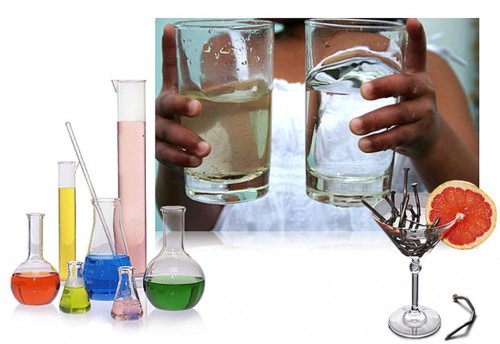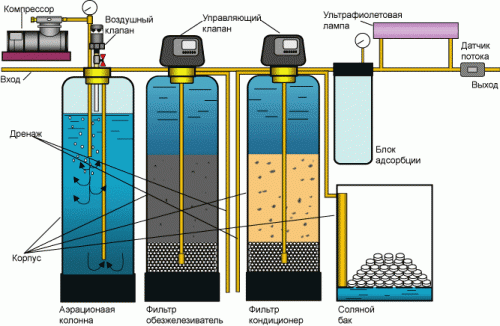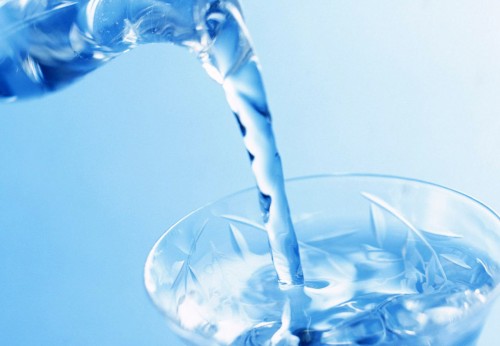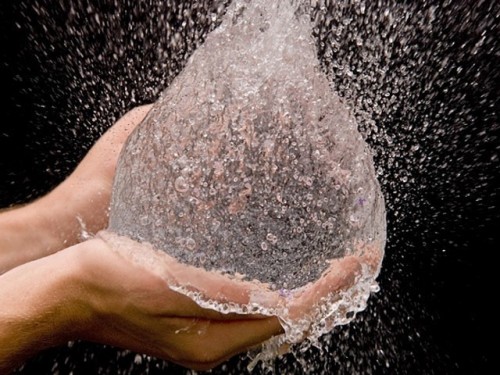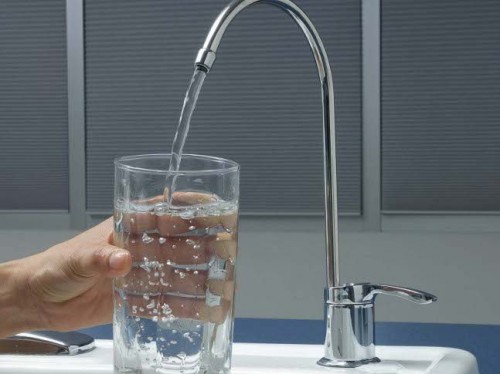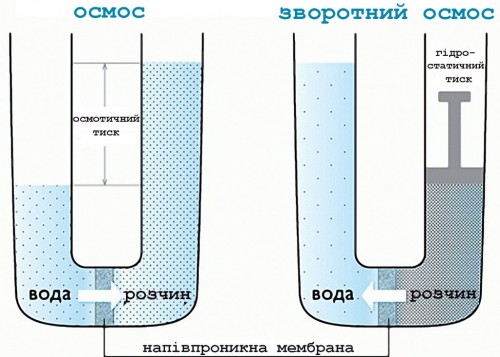
Clean water from the well. The main ways Useful advice
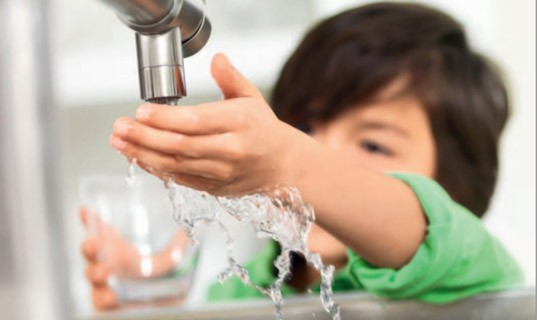
The optimal source of water in a country house in the absence of a central water supply wells. The current at the depth of 30 m, ground water is protected from harmful substances natural barrier surface. However, this does not deny the need for deep water purification.
Content
Due to lack of oxygen, water chemistry saturated high manganese and iron. This is evidenced by the yellow stains on the pumping equipment.
Clean water from the well: sequencing
Filtering the liquid is a complex purification procedures.
1. Clarification.
Starting considered lightening process. In this suspended and colloidal impurities are eliminated by fine filtering. To this end, developed washing filter parts and sediment filters.
2. De-ironing.
The second priority, but not the importance of the task - the cleansing composition of the dissolved iron compounds. Removal of chemicals based on iron passes using ion exchange method, or by means of the reagent or reagent-free iron removal process.
3. Softening.
The final stage of the process is considered to be softening. This water purification system from the hole is the elimination of the chemical composition of calcium and magnesium compounds. To do this, the most commonly used method of sodium cation exchange.
Types of water pollution
It is difficult to overestimate the importance of a lifeful moisture. Regarding, but pure useful water is less and less common in nature. Often, various impurities are found in the composition, as well as solutes. Water feature lies in the ability to dissolve many chemical elements of organic and inorganic origin. And some are harmful to the body exclusively in contact with others.
There are microorganisms in the form of impurities provoking acute intestinal diseases. They are:
- bacteria;
- mushrooms;
- viruses;
- the simplest organisms.
Excessive admission to the organism of any substances with water causes striking changes in the activities of human life support systems. Fine in the low concentration of substances, in the amount of above the permissible norm may result in irreversible processes.
There are a large number of water purification methods to normalize the composition. We list the most popular.
Preliminary cleaning
In case the source of drinking water is underground and surface water streams, it is recommended to produce a pinch preliminary cleaning. Stage includes the following procedures:
- Crediation with the use of reagents. Often the reagents are ignored - it all depends on the source data.
- Coagulation. Adding iron, aluminum or polyelectrolyte salts into the processed liquid is carried out to increase colloid and suspended fragments, as well as the transportation of particles into the filter.
- Water filtering (mechanical cleaning). Water purification filters from well, as a rule, multifunctional. To purify the tap water, the fine filtering method is used. In this case, the help comes:
- cartridge filters. These are devices in the form of a flask with an embedded filter part - the so-called patron. The exchange element after the service life is replaced;
- reverse wash devices. They are mesh filters on which mechanical pollution is settled. When reverse washing, the particles are washed off into the drainage system.
To maintain a water purification station from a well, cartridges (cartridges) and mesh filters of cell size from 5 μm up to 1 mm are used. In the role of material for filtering contaminants, depending on certain tasks, dolomite, quartz sand or anthracite is used. And the technique of preparing drinking surface or underground water provides fast pressure filters. Clearly speaking, they found the most widespread for this.
Water purification from iron
Integrated cleaning is used to eliminate or minimize iron compounds in water from the well. Based on this, no one will not dare to recommend certain universal techniques.
Note the most effective ways of debitals:
1. Processing by means of potent oxidizers:
- potassium permanganate;
- sodium hypochlorite;
- chlorine;
- ozone.
2. Aeration. This method provides for the discharge of oxygen into account with a stable oxidation process in the tank. Air flow indicators are about 30 l per 1 m³.
3. Filtration by modified loading. The method involves the passage of fluid through materials to eliminate iron. As a result, the filters purify water both from oxidized iron in the form of precipitate and from the dissolved element with the help of chemical processes.
The standard picture, accompanying the rise of iron water, is as follows:
- the water coming from the well seems absolutely transparent and clean;
- water container purges in a few minutes, acquiring a yellow shade;
- to the torment settles in a few hours, generating enough loose precipitate.
Deposition lasts from a pair of hours to several days. The speed of the process is directly related to the composition and temperature of the fluid. You can easily determine the presence of iron. A characteristic metal taste appears at a concentration of 1 mg of the chemical element per 1 liter of water.
Meanwhile, constant ignoring this issue can lead to unpleasant consequences for equipment and plumbing, namely:
- the formation of a steady yellow layer on enamel baths;
- home appliance facilities (washing, dishwashers);
- the failure of water heating systems and housing heating systems.
What is noteworthy, without the water purification station from the well, the heating and hot water system is guaranteed to fail. Upon exceeding the rate of iron content, flakes intensively formed in water, which in turn lead to the appearance of loose sludge. And he is the worst enemy of the passage of pipelines, radiators and heat exchangers. There is enough concentration of 0.5 mg / l for the separation narrowing of the pipe cross section.
Sanitary standards adopted in our country allow iron concentration to 0.3 mg / l in drinking water. As for underground sources of lightening moisture, the sanitary panels set the limit of up to 20 mg / l. And depending on the region, the value changes.
From the variety of water purification methods from the well, natural and mechanical are allocated. More precisely, the reagent and unreought -led.
In the first case, the technology involves using an additional reagent for filtering recovery. In the second - the flushing complex with water. However, purification from the heavy chemical element is allowed to be carried out exclusively by the reagent way. And both technologies apply in the complex cleaning of groundwater.
Cleaning hard water
Stiffness - the usual phenomenon for water. Everything is faced with him, it is enough to pay attention to the scale in the kettle. In water with a high degree of rigidity, soaps and other cleansing agents are not foaming. Such water is categorically not acceptable in brewing, the manufacture of alcoholic beverages, painting matter with water-soluble paints. Even the taste of sauces and mayonnaise, coffee and tea affects crude rigid water.
The degree of rigidity is calculated by the combination of dissolved salts of magnesium and sodium in the composition. Magnesium and calcium bicarbonates lead to the appearance of temporary or carbonate rigidity. It, in turn, is leveled by boiling water, but no later than 1 hour.
Soluble hydrocarbonates are transformed into insoluble carbonates when boiling, which form a scale or precipitate of the characteristic white color. The extraction of carbon dioxide accompanies the chemical conversion of water. As for the salts of strong acids, take at least chlorides and magnesium and calcium sulfates, with boiling constant or non-carbonate rigidity does not change.
Relief indicators of fresh drinking water reservoirs fluctuate depending on the time of year. The absolute minimum is fixed in periods of floods. And the artesian water has a much higher degree of rigidity relative to surface sources. The rigidity varies within 3-20 mg-eq / l. The effectiveness of cleaning the tight water depends largely on the depth of the well and location.
It is very important to remember that temporal rigidity converts unsuitable liquid from the water. It can not even be used in gas and electric boilers and hot water and heating boilers. I ignoring this aspect, you can get a significant layer of scale in a short time. At the same time, the 1.5 mm scale reduces the effect of heat transfer by 15%, a 10-mm - by more than 50%.
Reducing heat transfer leads to an inevitable overflow of electricity or fuel. This is accompanied by the occurrence of rogs, cracks on heating elements. It is safe to say that ignoring the cleaning of tight water from the artesian well is directly related to the premature breakage of water supply and heating devices.
To mitigate extremely rigid water use such cleaning methods:
- reagent;
- electrodialysis;
- distillation (so-called freezing);
- reverse osmosis;
- ion exchange;
- thermal;
- combined (includes combinations of all possible cleaning methods).
Water cleaning disinfection
The last significant barrier on the path of dangerous virus diseases and bacteria to the body is to disinfection. The cleaning process has an important value to ensure homeless drinking water. Disinfection is the final stage of the preparation of available water for use in the conditions of household. Since the use of underground and surface water is irrational for one way or another, the liquid is disinfected before use.
The list of traditional disinfection methods is as follows:
- Ultraviolet effect.
- Water purification by ozone.
- Chlorination of the fluid from the well (the addition of chlorine dioxide, calcium and magnesium hypochlorite, chlorine).
Other disinfection methods are used in exceptional cases. These are such rare methods:
- Radioactive radiation.
- Ultrasonic impact.
- Ionization of noble metals.
Experts claim that the choice in favor of a particular cleaning method is determined based on expenses and performance.
Water purification with activated coal
This method of purification of water is often used at the final cleaning stage. For manuals, this is one of the available means to obtain harmless drinking water. Additional cleaning in the form of filtering activated carbon comes to the aid when it is necessary to remove insignificant properties of water (smell, taste and color).
The product is also actively used for water purification procedures containing a large number of chlorine-containing compounds.
Water purification in reverse osmosis
This method is designed to help produce deep cleaning for drinking fluid. With standard pressure and temperature indicators, the quality of purification using reverse osmosis technology reaches 98%. Water purification is achieved by a semi-permeable membrane. These elements are made from acetatecellulose and polyamide and are rolls or hollow fibers. Through miniature pores, the membranes are skipped exclusively oxygen molecules and hydrogen. As for dissolved salts and compounds of organic origin in water, they are delayed in the membrane.
The quality of cleaning depends on the set of factors. First of all, this is the percentage of salt in raw water, the pressure, the composition of salt connections and the temperature.
Pre-cleaning provides filtering and chlorination. With this treatment, water will be responsible to the highest safety indicators. Manufacturers say that membranes allow you to get canceled water drinking water.
Conclusion
The market presents a huge number of products for cleaning underground and surface water. All of them are effective with the right integrated approach. However, there is one thing: in practice for effective purification and obtaining the best quality water, it is recommended to pre-obtain a detailed analysis of the composition of the produced water. Only having obtained results, you can move to an effective complex purification of water.




